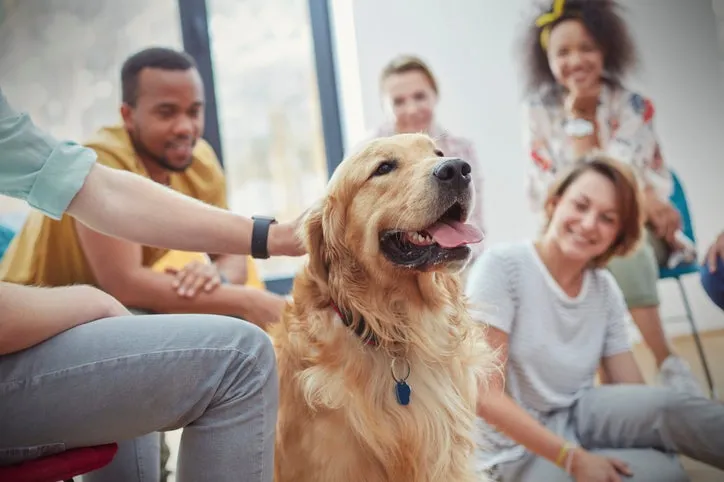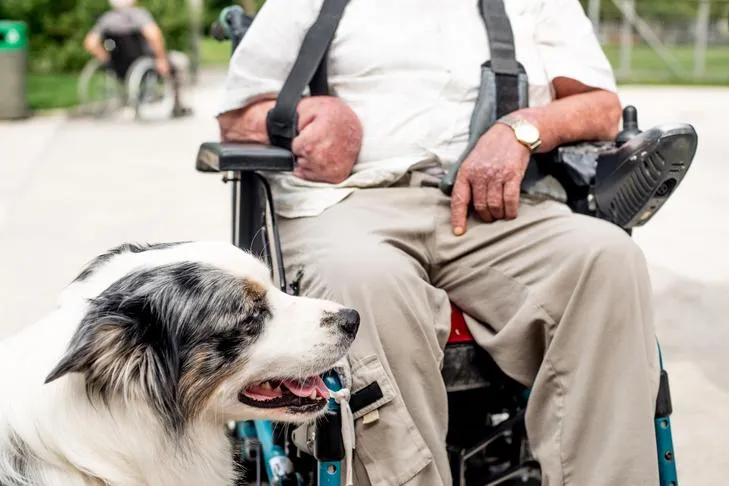The profound health benefits dogs bring to human lives are becoming increasingly recognized, leading to a surge in public interest surrounding therapy dogs. These remarkable canines offer comfort and solace in various anxiety-provoking situations, provide companionship to those feeling lonely or grieving, and spread affection in institutions like hospitals, nursing homes, and schools. If your dog is friendly, well-behaved, and has a natural affinity for people, you might be curious about how to train your dog to be a therapy dog and embark on this incredibly rewarding journey.
What Exactly is a Therapy Dog?
A therapy dog’s primary role is to provide comfort, affection, and emotional support to individuals, often in a facility setting or during specific visitations to help with physical or emotional challenges. It’s crucial to understand that therapy dogs are distinct from service dogs, which are specially trained to perform specific tasks for individuals with disabilities and are granted full public access rights under the Americans with Disabilities Act (ADA). Therapy dogs also differ from emotional support animals, which require a prescription from a mental health professional but do not necessitate specific training or certification.
The Profound Benefits of Therapy Dogs
Therapy dogs offer numerous physical and psychological benefits to the humans they visit. Their presence can help lower blood pressure and heart rate, reduce patient anxiety, and increase levels of feel-good hormones like endorphins and oxytocin. This benefit isn’t one-sided; studies have indicated that therapy dogs also gain from their work, exhibiting higher levels of endorphins and oxytocin compared to average family pets.
Linda Keehn, CPDT-KA, a therapy dog trainer, evaluator, and handler, and owner of Positive Canine Training and Services, highlights the diverse environments therapy dogs serve: “Therapy dogs go out to hospitals, nursing homes, libraries, schools, disasters. Essentially any venue where a clientele exists and it would be helpful for the dogs to be there.” However, simply taking your dog to visit a relative in a hospital isn’t an option. Therapy dogs require certification and registration with a reputable national organization. This certification is the culmination of a rigorous process that includes a temperament assessment and specialized training.
 A therapy dog undergoing a temperament test with an AKC evaluator in a controlled environment
A therapy dog undergoing a temperament test with an AKC evaluator in a controlled environment
Is Your Dog a Good Candidate for Therapy Work?
While your dog undoubtedly offers unconditional love, this alone doesn’t guarantee suitability for therapy work. Similarly, while you might be an empathetic individual, being an effective half of a therapy dog team requires specific attributes. So, what makes a good therapy dog, and how does a human-dog duo become a certified therapy team?
Most organizations require therapy dogs to be adults, typically not allowing puppies under one year old. Many also mandate that dogs pass the AKC Canine Good Citizen (CGC) test, a measure of basic obedience and good manners. Some organizations might substitute this with their own therapy-specific evaluations. Keehn, who trains and evaluates dogs for both CGC and therapy certification, underscores the critical importance of these skills for any therapy dog operating in public settings. A dog unable to follow commands like “leave it” or interact gently with children is unlikely to succeed.
Beyond these fundamental requirements, age and breed are less significant factors. Keehn has successfully tested dogs ranging from a tiny four-pound Yorkshire Terrier to a 13-year-old Beagle, both of whom excelled in their CGC tests. To ensure impartiality, Keehn only evaluates teams she has not personally trained. Ultimately, a therapy dog needs more than just basic obedience; it must possess a naturally social temperament, be calm rather than overly boisterous, and genuinely enjoy the “job.” Most dogs thrive with a purpose, and becoming a therapy dog can be a deeply fulfilling role for them. However, it’s essential not to force a dog into a role it doesn’t want. Consider ways to train your dog like a service dog to assess their aptitude for structured tasks.
Are You a Good Therapy Dog Handler?
The journey of training your dog to become a therapy dog opens up new horizons for both you and your canine companion, allowing you to contribute positively to your community. Keehn suggests joining a national or local therapy chapter to foster social connections for both you and your dog. She emphasizes that therapy dog work is mutually beneficial, enriching the handler’s life as much as the dog’s. However, handlers must be prepared for unforeseen interactions and responsibilities.
“Getting out of yourself and giving back to the community can improve your own mental and physical health,” Keehn states. “When you’re bringing a dog to a veterans’ organization or hospital, you may be the only non-medical person they’re seeing. It may be the only real conversation they’ve had for days. Be prepared as the therapy dog handler to connect to the client. It may be helpful to take a cognitive dog training course.”
Further valuable advice for handlers includes seeking mentorship from experienced handlers. Consulting a reputable dog trainer can also provide additional foundational knowledge and experience. Most therapy dog organizations offer extensive printed materials or website resources to help handlers prepare for their roles. Additionally, handlers often have the flexibility to choose their work environments. If your dog enjoys children, visiting schools or libraries might be ideal. Conversely, if that’s not a good fit for you, home visits with elderly individuals could be a more suitable option. For those interested in advanced obedience, learning how to train your dog to not use a leash can be a valuable skill, though generally not a requirement for therapy work.
 A dog handler engaging with a therapy dog, highlighting the bond and interaction essential for their role
A dog handler engaging with a therapy dog, highlighting the bond and interaction essential for their role
How to Train Your Dog to Become a Therapy Dog
You have the flexibility to either train a therapy dog independently or seek professional assistance. Keehn, who guides owners in preparing their dogs as part of a therapy team, recommends searching for formal organizations that feature well-educated trainers on their websites to support your training path.
For those for whom private training might be cost-prohibitive, Keehn advises reviewing the AKC Canine Good Citizen (CGC) test for its ten basic commands. Complement this by exploring instructional videos on platforms like YouTube. Participating in a group Canine Good Citizen class is another excellent option, potentially followed by more targeted and specialized classes. While mastering these ten commands is essential for passing the CGC test, the overall training process, especially when employing positive reinforcement, is invaluable and fosters lifelong skills. Understanding when should I start leash training my puppy can also lay a strong foundation for a well-behaved adult dog suitable for therapy work.
Keehn affirms, “Every time you interact with your dog, your dog is learning something. Reinforce the behavior you want. Keep your criteria at a level that your dog can handle. Be clear in your communication with non-verbal and verbal cues. You don’t need to touch the dog. They learn to follow their basic instincts to sit and lay down by doing what’s comfortable.” If you’re struggling with leash manners, consider resources on how to teach dog not to pull on lead.
 An Australian Shepherd emotional support dog sits calmly next to its senior owner, who is in a wheelchair
An Australian Shepherd emotional support dog sits calmly next to its senior owner, who is in a wheelchair
Essential Tips for Therapy Dog Training
Training a therapy dog is a significant undertaking that requires dedication from both the dog and its handler. It’s important to remember that even some of the most highly trained dogs may not be suitable for therapy work due to their inherent temperament. Conversely, certain dogs that are initially challenging to train can blossom into excellent therapy dogs with the right approach and consistent positive reinforcement. While the information above provides a comprehensive look at How To Train Your Dog Into A Therapy Dog, here are some foundational tips to kickstart your journey:
- Prioritize Temperament: A calm, friendly, and affectionate nature towards strangers is paramount. Your dog must genuinely enjoy interaction.
- Master Basic Obedience: Solid commands like sit, stay, come, and especially “leave it,” are non-negotiable for public settings.
- Socialization is Key: Expose your dog to various sights, sounds, smells, and people from a young age to ensure they are adaptable and comfortable in diverse environments.
- Positive Reinforcement: Reward desired behaviors consistently with treats, praise, and toys to build a strong, positive association with training.
- Practice in Different Settings: Gradually introduce your dog to new places and situations that mimic potential therapy environments to build confidence.
- Handler Preparedness: As a handler, be ready to engage with people, offering conversation and empathy alongside your dog.
Embarking on the path of training your dog to become a therapy dog is a deeply enriching experience, fostering a stronger bond between you and your companion while making a tangible difference in the lives of others.
